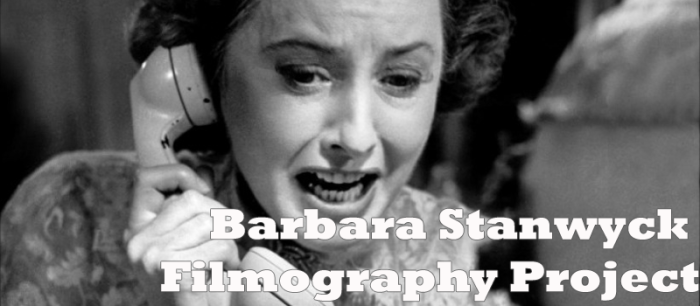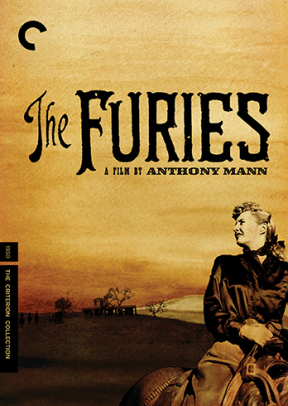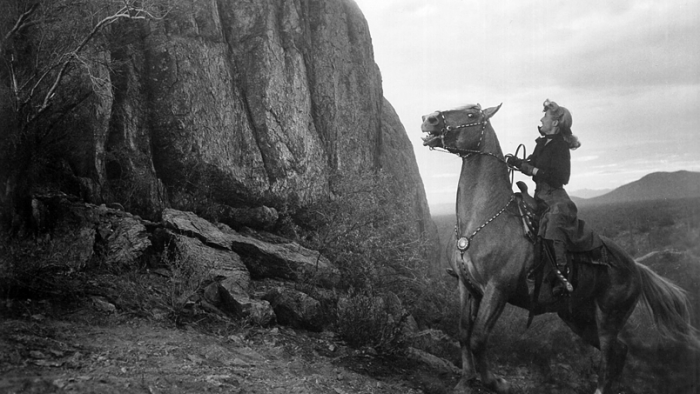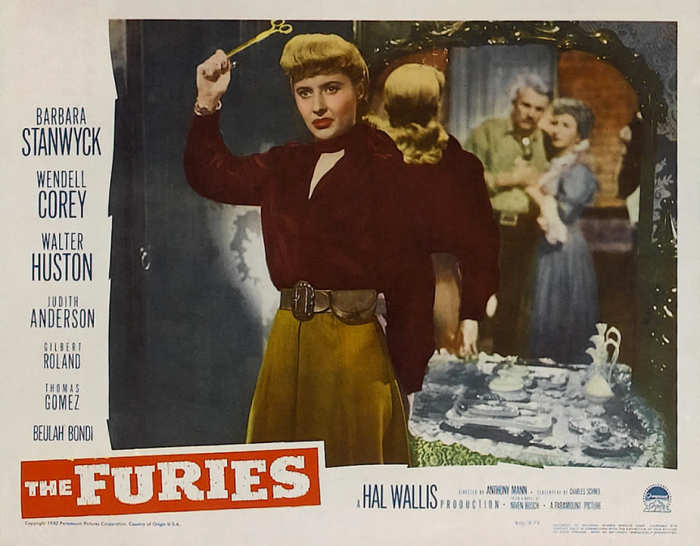
This film was viewed for the Barbara Stanwyck Filmography Project. For the rest of the Stanwyck reviews, visit the project index!
Originally published in 1948, Niven Busch’s novel The Furies was adapted to film with director Anthony Mann at the helm.
(Image via criterion.com)
Released in 1950, the film tells the story of the Jeffords family. Patriarch T. C. (Walter Huston) owns a New Mexico ranch, “The Furies.” His wife is long dead. His son (John Bromfield) is soon to be married. Left on the ranch with T. C. is his daughter, Vance (Barbara Stanwyck), who hopes to someday control the ranch.T. C. is fine with leaving the ranch to his daughter — if she can find the right man to marry, or choose not to marry at all. Complications ensue for the family as tensions over love and money put the future of the ranch in jeopardy.
I ordered Criterion’s DVD of The Furies thinking I’d simply watch the film for the Stanwyck Project, not really knowing much about it or its origins. Imagine my delight, then, when the DVD arrived on my doorstep with a book in tow! Criterion’s release of the film comes with a paperback edition of Busch’s novel.
Naturally, I wanted to read the novel before watching the film. It didn’t grab me from the beginning, but eventually, I was hooked. Busch’s novel gets soapy and incredibly dramatic as it progresses. There are romances, family drama, feuds, attempted murder, actual murder, gambling, and shady business dealings. Not exactly high-brow literary fiction, but a heck of a lot of fun to read once it gets going!

(Image via toutlecine.com)
The adaptation, under Mann’s direction, is every bit as interesting and almost as dramatic — but quite different. The film follows the major plot points of the book while making small changes, such as the order in which some minor events occur. For instance, when Darrow (Wendell Corey) is introduced in the film, he confronts T. C. before dancing with Vance. In the book, Vance’s attention is immediately caught by him when he arrives at the party. She dances with him first, and only becomes more impressed with him after he stands up to her father.Changes like this may seem insignificant, but they make a big difference in the way the story and characters are perceived.
T. C. seems far less controlling in the film than in the book, where his presence loomed over the ranch (and Vance’s every decision) in an oppressive, almost claustrophobic fashion.
“Always when she thought of these conditions, she could see T. C.’s figure towering before her, shouting that she could have all if she stayed.” – Busch demonstrates T. C.’s influence on Vance’s life, and the pressure he puts on her to make what he sees as the right decision.
Flo, the visitor T. C. brings to the ranch, is more of an overt schemer in the film, really seeming to want to take control of the ranch away from Vance, rather than simply falling in love with T.C. and with the land.
Vance, meanwhile, seems in many ways much more gold-digging and conniving in the film. In the world of the book, T. C. has executed so much control over Vance’s life. She’s given up a lot to stay at the ranch, and then suddenly feels that she might lose it all when Flo enters the picture. As wild as some of the book’s twists are, it’s easy to understand why Vance makes the choices she does, whereas in the film she sometimes comes across as plainly cruel.

(Image via theendofcinema.blogspot.com)
But that’s not to say she’s any less of a fascinating character on screen. It’s a pretty meaty role for a woman in a ’50s Western, not only as a crucial part of the story but as a character with some psychological depth. Stanwyck’s characterization of Vance is that of a desperate woman, willing to latch onto anything that is different from what she knows, and anything that can secure her future on The Furies. This desperation was also true of the character on the page, but I would say is her defining characteristic in the film. Even in her friendship with Juan, perhaps the most sincere of any of her relationships, she is drawn to him because he calls her out when she’s wrong, which no one else ever does.And speaking of Juan, there was one change from page to screen that really disappointed me, having read the book before watching: the minimization of the character of Juan, and his relationship with Vance. In the novel, Vance and Juan are in a relationship, and she breaks up with him because her father is returning to the ranch, knowing that T. C. won’t approve. He re-enters the story at a later time, playing a big role in the drama that occurs in the second half of the novel. In the film, it’s clear that Juan and Vance are friends, but when we meet him he’s on the ranch with his brothers, attempting to steal a calf. We see a bit of his relationship with Vance, and in one scene he admits he loves her, but that’s the extent of it.
It was censorship that stopped the Vance/Juan relationship from being portrayed on the big screen. A romance between a white woman and a Mexican man was deemed unacceptable in Hollywood at the time, which is a damn shame because I loved them in the book. In the film, too, it’s clear that Juan is the best choice for Vance. Even the censors couldn’t stop that from coming across! He may not have a massive ranch (as she stands to inherit if she chooses not to marry) or a successful saloon and bank (as operated by Rip Darrow, potential love interest), but Juan genuinely cares about Vance.
The removal of the Juan/Vance romance also removes a few of my favorite scenes from the book, including one that has a disgruntled T. C. showing up to Vance and Juan’s wedding, only to be completely ignored by his daughter, their relationship irreparably fractured.

(Image via doctormacro.com)
With all of these changes, the book has a slight advantage over the film, offering a detailed, vivid, complex story of family, love, money, and power.Still, the film is very well-made and I did enjoy watching it.
Stanwyck gives a wonderful performance, of course, even delivering one of her signature powerful rants in a particularly tense scene shared with Walter Huston. The tension between Stanwyck and Judith Anderson (portraying Flo Burnett) is also fantastic.
The black and white cinematography is stunning throughout, showcasing the expanses of the ranch as well as the dusty town where Rip Darrow runs his saloon.
While there were certain elements of the book I would have liked to see make it to the screen, The Furies offers plenty of entertainment, full of schemes and hatred.

(Image via moviestillsdb.com)
There’s a quote from the book which I think does a good job of summing up the heart of both book and film:“Hate was a real thing too — as real as love. If you let it soak into yourself long enough you didn’t want love. For love was a delicate thing, easily spoiled. Hate was tough: it could last forever. You could maintain hate by yourself, whereas love needed another person.”
With each of their unique versions of The Furies, Niven Busch and Anthony Mann crafted fascinating portrayals of love, hate, and the way these emotions can completely alter our lives — for better, or for worse.
Advertisements Share this:




